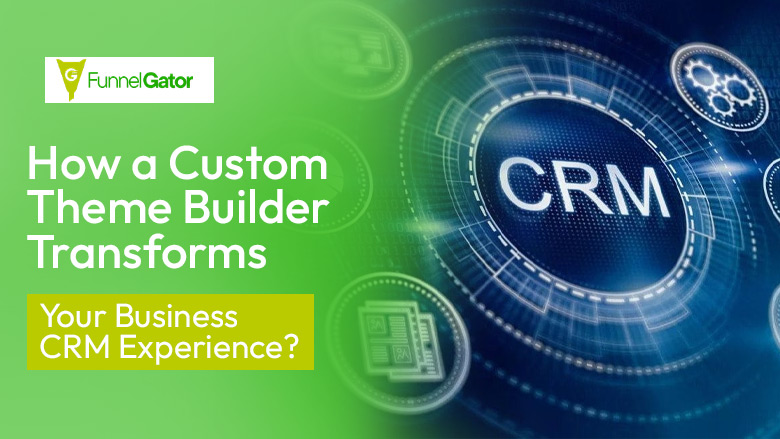
Custom Theme Builder to Transform Your CRM
Ever wondered why some CRMs feel instantly intuitive and productive, while others frustrate your team from day one? It’s not always about features, it’s about experience. And in the world of custom CRM system development, that experience begins with one secret weapon: a custom CRM theme builder.
In this blog, you will discover how customizing your CRM’s look, feel, and workflow through a theme builder doesn’t just make it prettier, it actually boosts adoption, productivity, and profitability.
We will walk you through the “why,” “how,” and “what’s next,” using practical insights, relatable examples, and a process you can follow to transform your CRM Custom Theme Builder experience from clunky to world-class.
What Is a Custom CRM System and Why Design Matters to Businesses?
Before we talk about themes and builders, let’s get one thing straight: Your custom CRM system is the brain of your business operations. It stores customer data, tracks leads, manages tasks, and supports your sales and service teams. But here’s the problem, most off-the-shelf CRMs try to fit every business under one design philosophy.
That’s like expecting one office layout to work for a law firm, a logistics company, and a florist. A custom CRM system development project changes that. It lets you build a CRM designed around your team’s behavior, not the other way around.
And when you add a custom CRM theme builder, you gain the power to visually and functionally tailor your CRM interface, layouts, dashboards, color schemes, modules, buttons, forms, and reports to match how your people actually work.
Why It Matters:
People adopt what feels familiar. A themed CRM aligns with your brand and daily workflow.
Design impacts focus — clean interfaces reduce cognitive load and task friction.
Visual consistency builds trust and clarity across teams.
In short, your CRM system customization is not an after thought, it’s the reason your team either loves your CRM or avoids it.
Why Businesses Need a Custom CRM Theme Builder Development
Imagine walking into an office where every desk is randomly placed, labels are inconsistent, and your files change folders daily. That’s what using a non-customized CRM feels like.
A custom theme builder for CRM online fixes that chaos. It’s a visual control panel that lets your admin or developer create, modify, and apply consistent design systems, without heavy coding.
Here’s how it transforms your CRM experience:
1. Improves User Adoption
Most CRM failures aren’t technical — they’re psychological.
If your CRM looks confusing or generic, employees hesitate to use it.
With a custom CRM theme builder, you can:
Adjust dashboards for different roles (sales, service, marketing).
Simplify navigation for everyday tasks.
Add branding elements that make users feel “at home.”
When your CRM feels like your company, adoption skyrockets.
2. Boosts Productivity
A tailored theme reduces the time your team spends searching for data. You can color-code pipelines, re-arrange widgets, and highlight action buttons that matter most. In one case study, a logistics firm improved ticket resolution time by 30% simply by re-theming its customer service CRM system for clarity and hierarchy.
3. Unifies Brand Identity
If your business prides itself on consistent branding from website to client portal and your CRM shouldn’t break that chain. A custom CRM theme builder for high level platforms allows you to unify brand visuals across dashboards, reports, and client views, reinforcing brand trust internally and externally.
4. Enhances Customer Service
Modern customer service CRM systems thrive on visual data. A themed dashboard with priority queues, ticket color codes, and live KPIs gives agents instant context. When combined with automation, this kind of CRM system customization can elevate the entire customer experience.
5. Pricing & ROI — When Does It Pay for Itself?

Time to payback: 6–18 months typical = CONVERSION MOMENT
Core Features of a Powerful Custom Theme Builder Software
A CRM theme builder software isn’t just about aesthetics but it’s about functionality.
Here’s what separates the best custom CRM theme builder tools from basic UI editors:
1. Drag-and-Drop Layout Editing
Reorganize dashboards, pipelines, and modules without coding. Perfect for marketing and service managers who want control without developer delays.
2. Role-Based Themes
Different roles → different needs. Sales reps can get lead-centric dashboards, while support agents see ticket queues and customer service modules first.
3. Color Logic and Visual Hierarchy
Colors aren’t decoration but they guide attention. The best custom theme builder for CRM lets you define color logic, like red for overdue leads or green for active deals.
4. Responsive & Mobile Customization
With remote work and mobile access rising, your CRM theme builder should let you design experiences that adapt across devices seamlessly.
5. Template Library & Branding Controls
Brand-aligned themes (logos, fonts, button styles) keep every module on-brand and professional, no more mismatched visuals.
6. Integration with Custom CRM Systems
A great theme builder integrates with custom CRM systems and modules whether for marketing, sales, or customer service, so the visual design extends across every tool.
How a Custom Theme Builder Enhances CRM System Development?
When planning custom CRM system development, design and structure usually come last but they shouldn’t. A theme builder bridges that gap between functionality and usability early in the process.
Here’s how it changes development for the better:
1. Shorter Development Time
With pre-built UI components and live previews, developers can skip repetitive styling work, focusing on logic, automation, and integrations instead.
2. Faster Iteration & Testing
Clients and teams can preview UI changes instantly, giving real-time feedback. No more waiting for version 5.0 to see if the layout works.
3. Modular Expansion
When your CRM grows, a theme builder ensures new modules inherit consistent design rules automatically.
4. Better ROI
Every minute saved in design and onboarding equals cost efficiency. Plus, users learn faster, reducing training overhead.
5. Enhanced Collaboration Between Teams
Developers, designers, and business teams can finally speak one visual language. When everyone sees what’s being built and why your CRM project moves faster and smarter.
Step-by-Step: How to Integrate a CRM Custom Theme Builder
If you are planning to build or revamp your CRM, here’s a simplified roadmap to ensure your custom CRM theme builder fits seamlessly into development.
Step 1: Define Your Core CRM Needs
Start with clarity. List what your CRM should accomplish with lead tracking, customer service, reporting, or workflow automation. This determines what modules and layouts your theme must support.
Step 2: Choose the Right Theme Builder Software
Evaluate CRM theme builder software that integrates with your development environment or CRM platform.
Prioritize tools offering:
Drag-and-drop design
Responsive UI templates
Real-time preview
Brand customization
Step 3: Map Your User Roles
Identify who will use the CRM services for either sales, marketing, support, admin. Then, plan unique dashboard themes for each. This is where theme builder for CRM flexibility shines.
Step 4: Create Brand-Aligned Templates
Use your logo, colors, and design language across modules. The goal? When users open your CRM, it should feel like your company’s control center, not a rented space.
Step 5: Implement and Test
Deploy the theme builder and run usability tests. Collect feedback early, are users finding data faster? Do colors or labels make sense?
Step 6: Iterate and Launch
Use data and user input to refine your themes. Once it’s stable, roll out across your organization.
Common Mistakes When Building a Custom Theme Builder

While CRM themes offer endless flexibility, businesses often stumble by over-complicating the process.
Here’s what to avoid:
Over-Designing:
Too many colors, widgets, and buttons confuse users. Keep it clean and purpose-driven.Ignoring User Roles:
Don’t give everyone the same dashboard and tailor views for specific job functions.Skipping Feedback Loops:
Design should evolve with real usage. Gather input from your team regularly.Not Testing Mobile UI:
Your CRM isn’t desktop-only anymore. Always test layouts on mobile and tablets.Neglecting Accessibility:
Contrast, font sizes, and readability matter for inclusivity and comfort.
Key Benefits of Using a Custom CRM Theme Builder
To recap, here’s why your custom CRM theme builder is more than a design add-on but it’s a performance engine:
Faster onboarding and easier learning curve
Consistent branding across all touchpoints
Role-based efficiency and personalization
Increased productivity and reduced task friction
Improved collaboration between departments
Seamless scalability as your CRM grows
These benefits ripple across departments from marketing managers identifying potential customers via CRM systems, to service teams using customer service modules in CRM systems to deliver faster, smarter responses.
How a Theme Builder Impacts Customer Service CRM Systems?
Customer service teams rely on speed, clarity, and information hierarchy. A theme builder enhances these through:
Dynamic color cues: Identify priority tickets instantly.
Simplified agent dashboards: Focus only on open tickets, customer context, and SLAs.
Customer service CRM system customization: Integrate customer data, communication logs, and chat history in one interface.
Analytics views: Monitor response times, customer sentiment, and agent performance visually.
When the interface supports your service flow, customer experience improves effortlessly.
The Future of Custom CRM System Development: Personalization with Flexibility
The future isn’t just custom CRMs, it’s customizable CRM experiences. As automation and AI become more accessible, the next generation of CRM system development services will combine:
Theme builders for visual flexibility
AI-powered dashboards for smart recommendations
Modular customization for rapid scaling
In essence, tomorrow’s CRMs won’t just store your data; they’ll speak your language, mirror your workflows, and look like your brand.
Practical Tip: Start Small, Scale Fast
You don’t have to overhaul everything overnight. Start with one department maybe customer service or sales and apply a custom CRM theme builder there first. Collect feedback, iterate, then roll out company-wide.
Remember: a successful CRM doesn’t just manage data — it creates a digital workspace your team enjoys using every day.
Conclusion: Turn Your CRM into a Competitive Advantage
Your CRM isn’t just a database, it’s where your sales happen, your customers connect, and your business decisions take shape. A custom CRM theme builder turns that space into something uniquely yours that is simple, intuitive, and powerful. When paired with expert custom CRM system development, you don’t just get software; you get a business ecosystem tailored to how your people think, work, and win.
So the next time you think of upgrading your CRM, don’t just ask, “What features do we need?”
Ask, “How should our CRM feel?” Because when your CRM feels like you, your business performs like never before.
Contact Funnel Gator today and get the perfect theme builder for your business today!
Key Takeaway:
The right custom CRM theme builder isn’t cosmetic but it’s strategic. It bridges the gap between functionality and adoption, helping you deliver smarter workflows, happier teams, and stronger customer relationships.
FAQs About Custom CRM Theme Builders
1. What is a CRM systems for customer service?
A custom CRM theme builder is a tool that allows you to visually design and personalize your CRM interface from colors to layouts without needing to code. It enhances usability and brand alignment.
2. Can I use a theme builder with my existing CRM system?
Yes, many CRM platforms now offer theme builder integration or APIs that let you customize existing dashboards and modules.
3. Is a theme builder useful for small businesses?
Absolutely. customer service modules in CRM systems provide tools for Small teams benefit the most because intuitive design reduces training time and increases Customer relation management system adoption quickly.
4. How does theme customization improve customer service?
CRM systems allow marketing managers to identify potential customers via critical data easy to find, streamlines workflows, and enables visual alerts for tickets or leads improving response time and customer satisfaction.
5. What’s the best way to get started?
Start by identifying your CRM pain points and goals. Then, choose a best custom CRM theme builder that aligns with your CRM platform or ask your custom CRM system development services provider to integrate one during the build.


